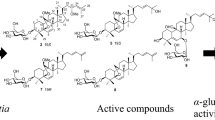Abstract
In addition to cucurbitacins E andI, cucurbitacins D,1, 3-epi-isocucurbitacin D,2, and B,3, were isolated from the fruits ofCucurbita texana and structurally identified by UV, IR,1H NMR,13C NMR, and MS, and 2-O-Β-glucopyranosylcucurbitacin I was identified. These compounds have not been reported previously as constituents of this species. The isolation of 3-epi-isocucurbitacin D2 together with normal cucurbitacins suggests that isocucurbitacins occur naturally. Evidence is also discussed that isocucurbitacins are biosynthesized one step ahead of normal cucurbitacin.
Similar content being viewed by others
References
Arisawa, M., Pezzuto, J.M., Kinghorn, A.D., Cordell, G.A., andFarnsworth, N.R. 1984. Plant anticancer agents XXX: Cucurbitacins fromIpomopsis aggregata (Polemoniaceae).J. Pharm. Sci. 73:411–413.
Balliano, G., Caputo, O., Viola, F., Delprino, L., andCattel, L. 1983. The transformation of 10α-cucurbita-5-24-dien-3Β-ol into cucurbitacin C by seedlings ofCucumis sativus.Phytochemistty 22:909–913.
DeHeer, C.J., andTallamy, D.W. 1991. Cucumber beetle larval affinity to cucurbitacins.Environ. Entomol. 20:775–781.
Duncan, G.R., Levi, D.D., andPyttel, R. 1968. Bitter principles of Cucurbitaceae—Bryonia dioica.Planta Med. 16:224–229.
Ferguson, J.E., andMetcalf, R.L. 1984. Cucurbitacins: Plant-derived defense compounds for controlling Diabroticite (Coleoptera Chrysomelidae).J. Chem. Ecol. 11:311.
Halaweish, F. 1987. Cucurbitacins in tissue cultures ofBryonia dioica Jacq. PhD thesis. University of Wales, Cardiff, U.K.
Hylands, P.J., andKosugi, J. 1982. Bryonoside and bryoside, new triterpene glycosides fromBryonia dioica. Jacq.Phytochemistry 21:1379–1385.
Hylands, P.J., andMagd, M. 1986. Cucurbitacins fromAcanthosicyos horridus.Phytochemistry 25:1681–1684.
Hylands, P.J., andMansour, El-S.S. 1983. New cucurbitacin derivatives fromBryonia dioica Jacq.J. Chem. Soc. Perkin Trans. 1:2821–2825.
Jacobs, H., Singh, T., Reynolds, W.F., andMcLean, S. 1990. Isolation and13C-NMR assignments of cucurbitacins fromCyanoponia angustloba, C. racemosa andGurania submrellata.J. Nat. Prod. 53:1600–1605.
Kupchan, S.M., Smith, R.M., Avnehchi, Y., andMaruyama, M. 1970. Tumor inhibitors LVI. cucurbitacins O, P, and Q, the cytotoxic principles ofBrandegea bigelovii.J. Org. Chem. 35:2891–2994.
Kupchan, S.M., Meshulam, H., andSneden, A.T. 1978. New cucurbitacins fromPhorium tenax andMarah oreganus.Phytochemistry 17:767–769.
Lavie, D., andGlotter, D. 1971. The cucurbitacins, a group of tetracyclic tritepenes.Fortschr. Chem. Org. Naturst. 29:306–364.
Metcalf, R.L. 1985. Plant kairmones and insect pest control. Bull.III Natur. Hist. Surv. 33:175.
Metcalf, R.L., andRhodes, A.M. 1985. Ca. Pat. 1,195,992.
Metcalf, R.L., Rhodes, A.M., Metcalf, R.A., Ferguson, J.E., Metcalf, E.R., andPo-Yung, L. 1982. Cucurbitacin contents and diabroticite (Coleoptera: Chrysomelidae) feeding uponCucurbita spp.Environ. Entomol. 11:931–937.
Metcalf, R.L., Ferguson, J.E., Lampman, R., andAnderson, J.F. 1987. Dry cucurbitacin-containing baits for controlling diabroticite beetles (Coleoptera: Chrysomelidae).J. Econ. Entomol. 80:870–875.
Polman, J. 1975. Die cucurbitacine inBryonia alba andBryonia dioica.Phytochemistry 14:1587–1589.
Tallamy, D.W., andKrischik, V.A. 1989. Variation and function of cucurbitacins inCucurbita: An examination of current hypotheses.Am. Nat. 133:766–786.
Velde, V.V., andLavie, D. 1983.13C NMR spectroscopy of cucurbitacins.Tetrahedron 39:317–321.
Witkowski, A., andKonopa, J. 1981. Selective inhibition of thymidine incorporation into lymphocytes by cucurbitacin B and D.Biochem. Biophys. Acta 674:246–250.
Witkowski, A., Woynarowska, B., andKonopa, J. 1984. Inhibition of the biosynthesis of deoxyribonucleic acid, ribonucleic acid and protein in HeLa S3 cell by cucurbitacins, glucocorticoid-like cytotoxic triterpenes.Biochem. Pharmacol. 33:995–998.
Whithouse, M., andDoskotch, W. 1969. Binding of the cytotoxic and antitumor tritepenes, cucurbitacins, to glucocorticoid receptor of HeLa cells.Biochem. Pharmacol. 18:1790–1793.
Author information
Authors and Affiliations
Rights and permissions
About this article
Cite this article
Halaweish, F.T. Cucurbitacins fromCucurbita texana: Evidence for the role of isocucurbitacins. J Chem Ecol 19, 29–37 (1993). https://doi.org/10.1007/BF00987468
Received:
Accepted:
Issue Date:
DOI: https://doi.org/10.1007/BF00987468




